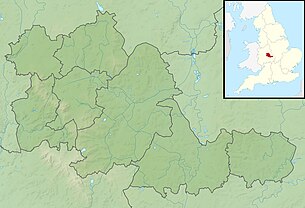Battle of Stourbridge Heath
| Battle of Stourbridge Heath | |||||||
|---|---|---|---|---|---|---|---|
| Part of the First English Civil War | |||||||
| |||||||
| Belligerents | |||||||
|
|
| ||||||
| Commanders and leaders | |||||||
| Sir Gilbert Gerard | Colonel "Tinker" Fox | ||||||
The Battle of Stourbridge Heath (26 March 1644) was a skirmish that took place during the First English Civil War, in which a Parliamentarian contingent under the command of Colonel "Tinker" Fox was defeated by a larger Royalist force under the command of Sir Gilbert Gerard, Governor of Worcester.[1]
Prelude
[edit]In 1644 Colonel Fox, led a raid that succeeded in capturing Stourton Castle. His brother held the castle for the Parliamentarians however a Royalist force under the command of Sir Gilbert Gerard, Governor of Worcester, was dispatched from Worcester to lay siege to the castle.
Despite pleas for assistance Tinker Fox received no support from Basil Feilding, Earl of Denbigh, the Parliamentarian commander. Fox had no choice then but to lead a relief force from Edgbaston. Fox, however, was intercepted at Stourbridge by the Royalists. Fox's forces were bolstered by the addition of 110 men from Coventry however without support from Denbigh he was in no position to match the force fielded by Gerard.[2]
Location
[edit]The exact location of the battle is unknown. The two forces met near Stourbridge on 26 March 1644. The heath at Stourbridge is located south of the town, somewhere in the vicinity of Mary Stevens Park, however during that period Stourbridge was surrounded by heathland.[3]
The battle
[edit]The battle was a resounding victory for the Royalists. Tinker Fox's forces were routed, with the gleeful Royalists claiming that Fox was the first to flee the battlefield. Exact casualties are unknown however, Royalist accounts claim that the routed Parliamentarians were pursued for three miles, with many killed.[4] Some prisoners were definitely taken by the Royalist forces, as Fox was later angered that men captured by the Royalists at Stourbridge Heath were not exchanged later in 1644 for a high ranking Royalist prisoner.[2] Continual disagreement and a real or imagined lack of support was a frequent feature of Fox's relationship with his parliamentary Commanders, particularly the Earl of Denbigh.
Aftermath
[edit]With no prospect of relief, the Parliamentary garrison at Stourton Castle was forced to surrender. Tinker Fox never again attempted to take on a large Royalist force directly, instead achieving remarkable success, notable the sacking of Bewdley[5] and the raid on Dudley a matter of hours after the departure of the Royalist forces from the town, through shrewd tactical understanding and the use of his extensive intelligence network. Fox finished the war as a senior officer appointed to the County Committee for Worcestershire. Gerard continued fighting in support of the Royalist cause, dying in 1646[6] and is buried at Worcester.[7]
Citations
[edit]- ^ Reports 1919, p. 386.
- ^ a b Hopper 1999, p. 108 (pdf 11).
- ^ Haden 2015.
- ^ Willis-Bund 1905, pp. 119–123.
- ^ Gilbert 2010, pp. 129–135.
- ^ Hutton 2002, p. 159.
- ^ Robinson 1843, p. 91.
References
[edit]- Gilbert, C.D. (2010), "A Dramatic Incident in Royalist Worcestershire: 'Tinker' Fox's Raid on Bewdley of May 1644", Midland History, 35 (1): 129–135, doi:10.1179/004772910X12629513109056, S2CID 159946740
- Haden, H. Jack (20 February 2015), About Stourbridge - this historic town in the English West Midlands, retrieved 25 August 2017
- Hopper, Andrew J. (1999), "'Tinker' Fox and the politics of Garrison Warfare in the West Midlands 1643-50" (PDF), Midland History, 24, Maney Publishing: 98–113, doi:10.1179/mdh.1999.24.1.98, hdl:2381/361
- Hutton, Ronald (2002), The Royalist War Effort 1642-1646 (2nd illustrated, revised ed.), Routledge, ISBN 9780203006122
- Reports and Papers of the Architectural and Archaeological Societies of the Counties of Lincoln and Northampton (Volume 35, Parts 1-2), 1919
- Robinson, Edward (1843), Beamont, William (ed.), A discourse of the warr in Lancashire, Remains, historical and literary, connected with the palatine counties of Lancaster and Chester, vol. 62, Chetham society
- Willis-Bund, John William (1905), The Civil War in Worcestershire 1642-1646 and the Scotch invasion of 1651, Simpkin, Marshall, Hamilton, Kent and Company

